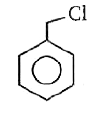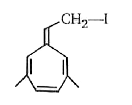Why is t- butyl bromide more reactive towards reaction as compared to n- butyl bromide?
To understand why t-butyl bromide is more reactive towards the SN1 reaction compared to n-butyl bromide, we need to analyze the structures and the stability of the carbocations formed during the reaction.
Step 1: Identify the Structures
- Tertiary Butyl Bromide (t-butyl bromide): The structure is (CH3)3CBr.
- n-Butyl Bromide: The structure is CH3CH2CH2Br.
Step 2: Understand the Mechanism of SN1 Reactions
The SN1 reaction mechanism involves two main steps:
1. Formation of a carbocation by the loss of the leaving group (bromide ion in this case).
2. Nucleophilic attack on the carbocation.
Step 3: Carbocation Stability
The stability of the carbocation formed in the first step is crucial for the reactivity in SN1 reactions:
- Tertiary Carbocation: The carbocation formed from t-butyl bromide is tertiary, meaning it is attached to three alkyl groups. This structure provides significant hyperconjugation and inductive effects, which stabilize the positive charge.
Tertiary Carbocation: (CH3)3C+
- Primary Carbocation: The carbocation formed from n-butyl bromide is primary, attached to only one alkyl group. This structure is less stable due to limited hyperconjugation and inductive effects.
Primary Carbocation: CH3CH2CH+2
Step 4: Compare Stability
- The tertiary carbocation is more stable than the primary carbocation because:
- It has more alkyl groups that can donate electron density through hyperconjugation.
- The positive charge is better stabilized by the surrounding alkyl groups.
Step 5: Conclusion
Since the SN1 reaction rate is dependent on the stability of the carbocation, t-butyl bromide, which forms a more stable tertiary carbocation, is more reactive towards SN1 reactions compared to n-butyl bromide, which forms a less stable primary carbocation.
Summary
- Tertiary butyl bromide forms a stable tertiary carbocation.
- n-butyl bromide forms a less stable primary carbocation.
- The stability of the carbocation directly influences the reactivity in SN1 reactions.
- Tertiary Butyl Bromide (t-butyl bromide): The structure is (CH3)3CBr.
- n-Butyl Bromide: The structure is CH3CH2CH2Br.
The SN1 reaction mechanism involves two main steps:
1. Formation of a carbocation by the loss of the leaving group (bromide ion in this case).
2. Nucleophilic attack on the carbocation.
The stability of the carbocation formed in the first step is crucial for the reactivity in SN1 reactions:
- Tertiary Carbocation: The carbocation formed from t-butyl bromide is tertiary, meaning it is attached to three alkyl groups. This structure provides significant hyperconjugation and inductive effects, which stabilize the positive charge.
Tertiary Carbocation: (CH3)3C+
- The tertiary carbocation is more stable than the primary carbocation because:
- It has more alkyl groups that can donate electron density through hyperconjugation.
- The positive charge is better stabilized by the surrounding alkyl groups.
Since the SN1 reaction rate is dependent on the stability of the carbocation, t-butyl bromide, which forms a more stable tertiary carbocation, is more reactive towards SN1 reactions compared to n-butyl bromide, which forms a less stable primary carbocation.
- Tertiary butyl bromide forms a stable tertiary carbocation.
- n-butyl bromide forms a less stable primary carbocation.
- The stability of the carbocation directly influences the reactivity in SN1 reactions.
Topper's Solved these Questions
- XII BOARDSBOOK - XII BOARD PREVIOUS YEAR PAPER ENGLISHCHAPTER - XII BOARDSEXERCISE - SECTION-B
22 Videos
- XII BOARDSBOOK - XII BOARD PREVIOUS YEAR PAPER ENGLISHCHAPTER - XII BOARDSEXERCISE - SECTION-C
28 Videos
- XII BOARDSBOOK - XII BOARD PREVIOUS YEAR PAPER ENGLISHCHAPTER - XII BOARDSEXERCISE - Outside Delhi : SET-III
11 Videos
- SAMPLE PAPER 2019BOOK - XII BOARD PREVIOUS YEAR PAPER ENGLISHCHAPTER - SAMPLE PAPER 2019EXERCISE - SECTION: D
1 Videos
Similar Questions
Knowledge Check
Which of the following is most reactive towardSN2 reaction ?
A B
B C
C D
D
Which of the following is most reactive towardSN2 reaction ?
ACH2=CH−CH2−ClBPh−CH2−ClC DPh−C∣∣O−CH2−Cl
DPh−C∣∣O−CH2−ClMost reactive compound toward SN1 is :
A B
B C
C D
D
Which one is most reactive towards SN1 reaction?
View SolutionThe correct order of reactivity towards SN1 reaction is

View SolutionMost reactive halide towards SN1 reactions is
View SolutionWhich of these shows highest reactivity towards SN2 reaction?
View SolutionDraw structure for n-pentyl bromide
View Solution
